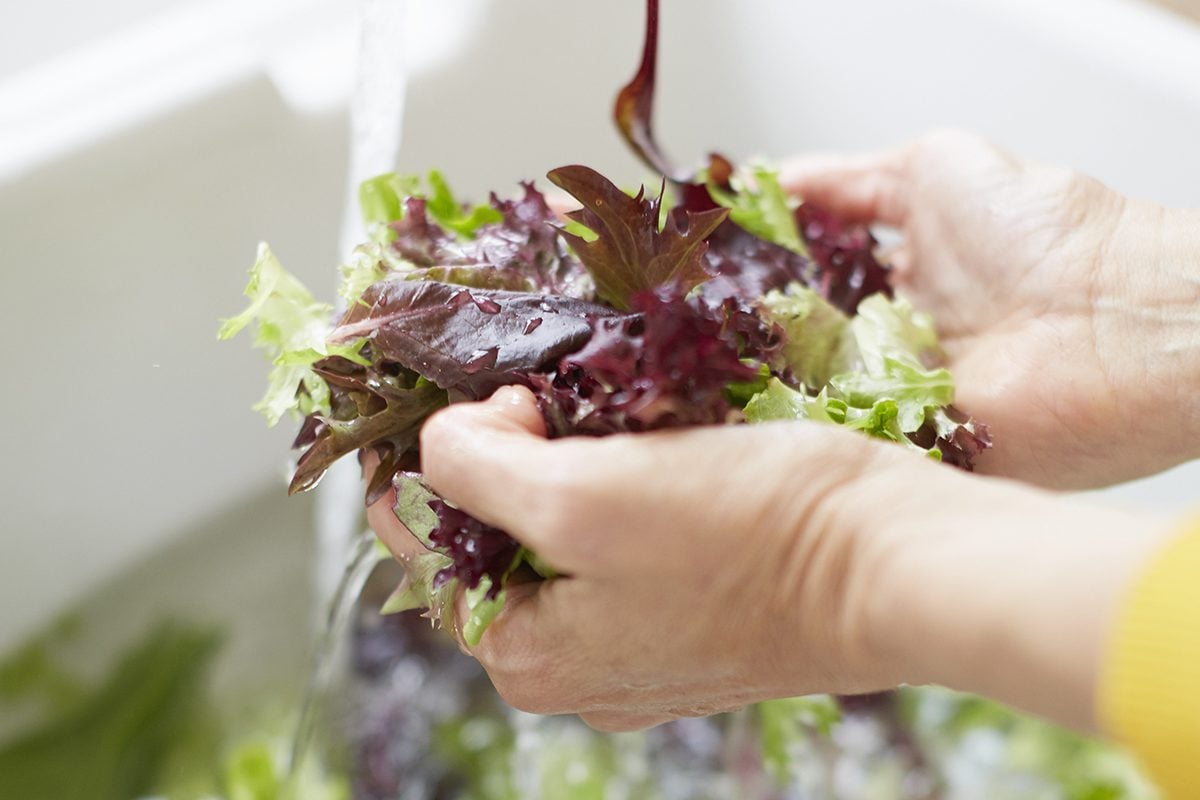Pork and Balsamic Strawberry SaladServing this entree salad gives me hope that warmer days aren't too far off. If strawberries aren't in season yet, use thawed frozen in place of fresh. —Laurie Lufkin, Essex, Massachusetts
Like this? Try this 7-day
salad meal plan for healthy, nutritious meals.
Fajita in a BowlPull out the skewers and take a stab at grilling peppers, onions and corn for an awesome steak salad that’s all summer and smoke. —Taste of Home Test Kitchen, Milwaukee, Wisconsin
Tarragon Tuna SaladIt's surprising how a few herbs can brighten up tuna salad. Made with reduced-fat mayonnaise, this version gets its zip from mustard. It makes a terrific light lunch or Sunday brunch dish. —Billie Moss, Walnut Creek, California
Turkey and Apple Arugula SaladThis satisfying salad proves that turkey can be enjoyed outside of the holidays. Peppery salad greens, sweet grapes and rich walnuts combine to create a flavor sensation. —Nancy Heishman, Las Vegas, Nevada
Yellow Squash Turkey SaladWith a wonderful mix of flavors, colors and textures, this impressive salad can be made in minutes for lunch with a friend or for a light dinner with your sweetie. It’s my favorite fast recipe! —Mildred Sherrer, Fort Worth, Texas
Grilled Asian Chicken Pasta SaladFor your next get-together, try this Asian pasta salad instead of the traditional kind. It's full of bright, summery flavors, and the grilled chicken makes it a complete meal.
BLT Turkey SaladThis variation of a BLT salad is great with a side of garlic bread or garlic toast, and will satisfy even the pickiest eaters. —Sherry Conley, Noel, Nova Scotia
Greek Brown and Wild Rice BowlsThis fresh rice dish tastes like the Mediterranean in a bowl! It is short on ingredients but packs in so much flavor. For a hand-held version, leave out the rice and tuck the rest of the ingredients in a pita pocket. —Darla Andrews, Boerne, Texas
Tasty Taco Chopped SaladMy friends and I love Mexican food, but we try to eat healthy. My mom taught me how to make this tasty taco salad for my friends. —Matthew Smith, Knippa, Texas
Herbed Tuna and White Bean SaladThis is a quick and delicious salad that can be made special for guests—or yourself—by grilling fresh tuna steaks instead of using canned. —Charlene Chambers, Ormond Beach, Florida
Shrimp Scampi Spinach SaladMy husband and I really enjoy both shrimp scampi and fresh spinach salad, so I put the two together. My oldest son loves it, too, and he's only 3! —Jamie Porter, Garnett, Kansas
Chicken Caesar Pasta SaladChicken Caesar pasta salad is like the Goldilocks of lunch ideas. It’s perfect when you’re too hungry for a salad, but not hungry enough for a heavy pasta dish.
Jambalaya Rice SaladMy cold rice salad has a little hint of spice for a classic jambalaya-style kick. Shrimp, tomatoes, ham and peppers give the dish bright colors and a delightful texture. —Karen Rahn, Hixon, Tennessee
Almond-Apricot Chicken SaladHere's a one-of-a-kind pasta salad that combines tender chicken, sweet apricots and crunchy vegetables. Plus, the lemony dressing can't be beat. —Susan Voigt, Plymouth, Minnesota
Chicken Fajita SaladThis recipe came from Texas, which is famous for its Mexican food. I love to cook, even though it's just for me and my husband now. I invite our grown kids over a lot, and they just love this chicken fajita salad. I'm happy to share it! —Lois Proudfit, Eugene, Oregon
Ground Beef Taco SaladIn spring we look for something light and refreshing on the menu after the heavier comfort food of winter; this salad is a great solution. —Muriel Bertrand, Shoreview, Minnesota
Spinach Salad with Tortellini & Roasted OnionsSpinach and tortellini go so well together, and this salad makes an easy meal with leftover cooked chicken. What really makes it special is the roasted onion that adds oomph to bottled salad dressing. —Robin Haas, Hyde Park, Massachusetts
Chicken Tostada SaladIf I don't have any tostada shells on hand for this speedy salad, I just heat taco shells, break them in half and lay them flat on the plates. It works just as well. Great Southwest flavor! —Edie DeSpain, Logan, Utah
Grilled Jerk Shrimp Orzo SaladThe heat, seasonings and appearance of this colorful main-dish salad are perfect for summer—or any time of year that you want to summon memories of sunshine. —Eileen Budnyk, Palm Beach Gardens, Florida
Chicken Taco SaladTen minutes of prep are all you need to make this delicious chicken taco salad. The slow cooker does the rest of the work, creating a satisfying and easy-to-make meal even on the busiest of weeknights.
Veggie Nicoise SaladMore and more people in my workplace are becoming vegetarians. When we cook or eat together, the focus is on fresh produce. This salad combines some of our favorite ingredients in one dish—and with the hard-boiled eggs and kidney beans, it delivers enough protein to satisfy those who are skeptical of vegetarian fare. —Elizabeth Kelley, Chicago, Illinois
Chicken Pasta SaladChicken pasta salad can be a light, healthy lunch in its own right, not just a side dish. This one is especially healthy, thanks to its use of whole wheat pasta and especially its hummus-based dressing.
Shrimp & Nectarine SaladFor a cool salad on a hot summer day, I combine shrimp, corn, tomatoes and nectarines with a drizzle of tarragon dressing. We love it chilled, but it's delectable served right away, too. —Mary Ann Lee, Clifton Park, New York
Grilled Chicken Salad with Blueberry VinaigretteWe love adding grilled chicken to our salads in the summer, but the real star here is the vinaigrette made with blueberry preserves and maple syrup. This salad goes great with a fresh baguette and a frosty glass of minted lemonade. —Susan Gauthier, Falmouth, Maine
Mimi's Lentil MedleyI made this one summer evening by putting together what I had on hand. My husband gave it his top rating. —Mary Ann Hazen, Rochester Hills, Michigan
Garden Quinoa SaladThis recipe is special to me because it’s delicious as well as healthful. Serve it hot or cold, and enjoy the leftovers while they’re fresh! —Patricia Nieh, Portola Valley, California
Whole Wheat Orzo SaladIn less than 30 minutes, I can put together this hearty salad of pasta, white beans and veggies – and it’s good for a crowd. — Mya Zeronis, Pittsburgh, Pennsylvania
Steak SaladThis classic steak salad recipe features a perfectly cooked, well-seasoned steak atop a hearty mix of greens and toppings. It's a nutritious and quick dinner perfect for any night of the week.
Orzo-Tuna Salad with TomatoesStuffed tomatoes provide endless options when you add meat, cheese, rice, veggies – or in this case, orzo. — Jenni Dise, Phoenix, Arizona
Ginger-Cashew Chicken SaladI revamped an Asian-style chicken salad recipe to create this gingery, crunchy salad. Now it’s a huge success when I serve it at ladies luncheons. —Shelly Gramer, Long Beach, California
Chicken Quinoa SaladWe pile our favorite gyro fixin’s into nutritious quinoa bowls. Our local gyro guy has a cool but spicy sauce that transforms his sandwiches. It’s a must here, too. —Leah Lyon, Ada, Oklahoma
Thai Spinach Beef SaladHere's a main-dish salad that's just plain fun to eat. It's crunchy, beefy and has a little kick. Best of all, it's good for you. —Janet Dingler, Cedartown, Georgia
Classic Cobb SaladMaking this salad is a lot like putting in a garden. I plant everything in nice, neat sections, just as I do with seedlings. —Patricia Kile, Elizabethtown, Pennsylvania
Apple Sausage Salad with Cinnamon VinaigretteMaking croutons with cinnamon-raisin bread is sweet genius. Toss together the rest of the salad while they toast. —Kim Van Dunk, Caldwell, New Jersey
Mediterranean Spinach & BeansIf you want to make this dish vegetarian, use soy sauce instead of Worcestershire. I like this skillet meal served warm or cold. —Becky Cuba, Spotsylvania, Virginia
Gingered Spaghetti SaladWe love this chilled chicken salad brimming with colorful veggies. Make it meatless by omitting the chicken and tossing in more edamame. —Cindy Heinbaugh, Aurora, Colorado
Veggie Steak SaladThis salad just explodes with flavors. It's easy and quick to prepare, tastes delicious, and is a healthy dinner all on one plate. —Tiffany Martinez, Aliso Viejo, California
Bow Tie & Spinach SaladWith pasta salad, it’s easy to change up ingredients. We like to add grilled chicken and pine nuts, and sometimes we substitute black beans for the garbanzo beans. —Julie Kirkpatrick, Billings, Montana
Tuna Nicoise SaladTuna Nicoise salad is a perfect lunch for a weekend or even to make ahead for the work week. Our recipe is traditional with tuna, tomatoes and beans, but is easily adaptable to suit your tastes.
Cashew-Curry Chicken SaladMy husband and I fell hard for the curried chicken salad from our grocery store deli, and I knew I could find a way to make something similar. This greek yogurt chicken salad has become one of our favorites to take on trips to the beach. —Janine Cooper-Moren, Portland, Oregon
Pear Chicken Salad with Maple VinaigretteClassic pear salad gets an innovative makeover with chicken and maple vinaigrette. We like to serve it over crisp romaine for a refreshing experience. —Chrysa Duran, Cambridge, Minnesota
Cool & Crunchy Chicken SaladWhen the weather sizzles, get your chill on with a cool chicken salad. Mine uses grapes, pecans and celery for that signature crunch. —Sarah Smiley, Bangor, Maine
Thai-Style Cobb SaladThis veggie salad is like a mix of Cobb salad and my favorite summer rolls. If you have leftover chicken, toss it in. —Elisabeth Larsen, Pleasant Grove, Utah
Arugula & Brown Rice SaladWhen we have company, arugula with brown rice is always on the menu. It’s my go-to pick for the potluck and party circuit, and I'm always sharing the recipe. —Mindy Oswalt, Winnetka, California
Southwest Shredded Pork SaladThis knockout shredded pork makes a healthy, delicious and hearty salad with black beans, corn, cotija cheese and plenty of fresh greens. —Mary Shivers, Ada, Oklahoma
Sesame Beef & Asparagus SaladCooking is one of my favorite hobbies—especially when it comes to experimenting with fresh ingredients like these. This meaty salad is wonderful at the start of asparagus season. —Tamara Steeb, Issaquah, Washington
California Burger BowlsBurgers are a weekly staple at our house year-round. Skip the fries, chips and bun—you won't need them with these loaded veggie and fruit burgers. To spice up the mayo, add 1/2 tsp. of chipotle powder. —Courtney Stultz, Weir, Kansas
Salmon and Spud SaladI headed straight for the kitchen when I decided to pick up a healthier lifestyle. This salmon with veggies proves that smart choices can be simple and satisfying. —Matthew Teixeira, Milton, Ontario
Warm Rice & Pintos SaladDuring my undergrad years, my roommate taught me how to cook vegetarian dishes like brown rice with pintos. It's so versatile; you can turn it into a wrap or casserole. —Natalie Van Apeldoorn, Vancouver, British Columbia
Edamame Salad with Sesame Ginger DressingThis bright baby kale salad is packed with a little bit of everything: hearty greens, a nutty crunch, a zip of citrusy goodness and a big protein punch. It's pure bliss in a bowl. —Darla Andrews, Schertz, Texas
Sesame Chicken Slaw SaladI tasted many types of Asian chicken salad in California. When I moved back to Georgia, I wanted more. Here’s a gingery-sweet recipe using wonton strips. —Michelle Mulrain, Evans, Georgia
Twisted Eggs Benedict SaladSalad for breakfast? Absolutely. You can prep everything except the dressing and chill it overnight. In the morning, dress the salad and poach the eggs. —Noelle Myers, Grand Forks, North Dakota
Shrimp Avocado SaladShrimp avocado salad mixes tender shellfish with fresh vegetables for a cool, protein-filled lunch or easy light dinner.
Mediterranean Bulgur BowlYou can also transform this tasty bowl into an Italian version with mozzarella, pesto, tomatoes, spinach and basil. —Renata Smith, Brookline, Massachusetts
Grilled Southwestern Steak SaladPasta salad loaded with steak, peppers and onions makes both my boyfriend and me happy. Plus, it’s versatile! We serve it hot, room temperature or cold. —Yvonne Starlin, Westmoreland, Tennessee
Ham & Mandarin SaladI created this salad at the request of all the men in our house. They asked for something tangy, sweet, spicy and manly. This fit the bill. —Patricia Swart, Galloway, New Jersey
Strawberry-Blue Cheese Steak SaladAt lunch one day, a friend told me about a steak salad she'd had at a party. It sounded so fantastic I had to try it for myself. My family would eat it nonstop if we could. Can't seem to get enough of that tangy dressing! —Alma Winberry, Great Falls, Montana
Berry Chicken SaladBright berries and creamy goat cheese make this one a winner! —Wendy Ball, Battle Creek, Michigan
Avocado & Garbanzo Bean Quinoa SaladThis delicious quinoa avocado salad is high in protein and holds well in the fridge for a few days. If you make it ahead, add avocados and tomatoes right before serving. —Elizabeth Bennett, Seattle, Washington
Strawberry-Quinoa Spinach SaladWe make quinoa with spinach and strawberries year-round, but it's most fun when we go to the farmers market to get the season’s first berries. —Sarah Johnson, Indianapolis, Indiana
Skinny Cobb SaladThis skinny version of Cobb salad has all the taste and creaminess with half the fat and calories. You can skip the coleslaw mix and use all lettuce, but I like the crunch you get with cabbage. —Taylor Kiser, Brandon, Florida
Asparagus Nicoise SaladI’ve used my Nicoise as an appetizer or a main-dish salad, and it’s a winner every time I put it on the table. Here’s to a colorful, make-ahead salad! —Jan Meyer, St. Paul, Minnesota
Chicken Nicoise SaladThis salad makes it easy to eat what’s good for you. It’s versatile, so you can use asparagus in place of green beans and salmon instead of tuna, or add garden tomatoes. And if you follow the keto diet, you'll be happy to know this is a keto chicken salad. —Nick Monfre, Oak Ridge, New Jersey
Orange Chicken Spinach SaladFor a salad with refreshing color and crunch, we toss chicken and spinach with mandarin oranges and red onion, then splash everything with a tangy vinaigrette. —Jean Murawski, Grosse Pointe Park, Michigan
Vietnamese Noodle Salad with PorkEnjoy this Vietnamese noodle salad with pork, combining crisp vegetables, fresh herbs and tender pork in a bright lime dressing for a light, refreshing meal.
Summer Splash Chicken SaladWhen it’s too hot to eat inside, I head out to the patio. Shred some rotisserie chicken and toss with mango, watermelon and grapes for an ooh-ahh healthy chicken salad. —Barbara Spitzer, Lodi, California
Strawberry-Turkey Spinach SaladThis light, refreshing salad is a true showstopper, visually and nutritionally, with fresh strawberries and yellow pepper strips tossed with fresh baby spinach. Serve with warm whole wheat rolls or flax or bran muffins. —Taste of Home Test Kitchen, Milwaukee, Wisconsin
Tropical Fusion Salad with Spicy Tortilla RibbonsFresh fruits and veggies pair up for a fantastic summer salad that's savory, sweet and spicy all at once. Make the tortilla strips with your pizza cutter—so easy! —Jennifer Fisher, Austin, Texas



























































































